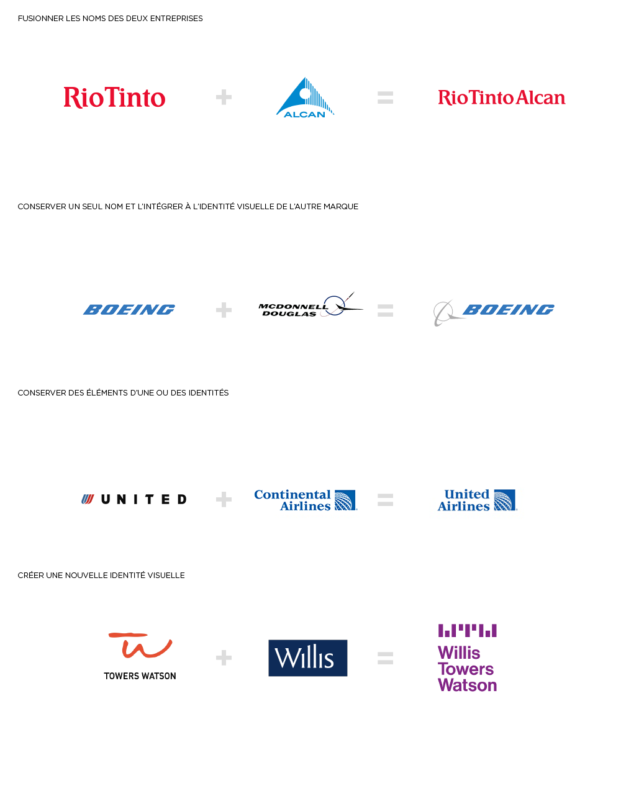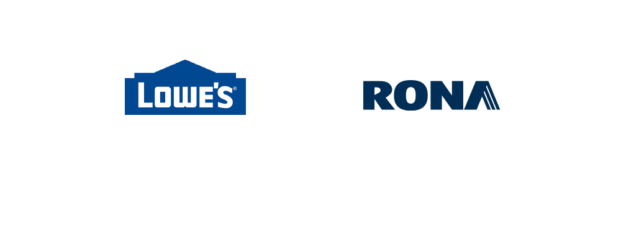When two companies merge, or when a company buys out another, both parties work hard at implementing the best deal possible, thereby ensuring new peaks in performance for the newly formed organization. Legal, financial and tax consultants are gathered. Products and services are put forward, along with client lists and territories. Management styles and equipment are compared. Everything and anything that's quantifiable and forecastable is carefully covered. However, in this rush to settle the more tangible aspects of the transaction, issues pertaining to the brand are all too often neglected. Despite the fact that, if these issues aren't addressed quickly enough, they can have a negative effect on the proper execution of an extremely delicate operation. BrandBourg has helped many clients revamp their brands after a merger or an acquisition. Our experience has allowed us to determine success factors in this very specific context.
A brand is usually the company asset with the most longevity. Therefore, decisions concerning the brand deserve serious consideration. We actually estimate that three to six months are required to realign a brand before its deployment.
This period includes strategic planning, creative design and every aspect of this new and improved brand’s launch and deployment. Since the full commitment of all teams involved in the brand project will be crucial to the operation’s success, communicating information to employees will require extra care.
Revamping a brand in three steps
A good transition plan will include brand strategy, identity and communication.
1. Re-evaluating the brand strategy
After a merger or acquisition, the brand’s ecosystem is redefined under the influence of the new players. This can be attributed to the emergence of a new vision, a redefined competitive landscape, the rationalization of products and services, and new markets, technologies, or distribution channels.
Faced with these realities, the brand strategy will be re-evaluated and the relevance of a repositioning will be examined. What are this new organization’s key messages, its value proposition, its benefits for the targeted markets? These are some of the elements linked to the current economic situation, market and players in the field.
Well-defined brand anchors will allow for clearer identity-related issues, by minimizing the emotional factor in favour of a more strategic approach.
2. Revamping or redesigning the brand’s identity
In the context of a merger or acquisition, it’s hard to avoid the discussion about the company’s name. Should we keep both names, keep only one or create a new one? Will we want to transform the name of one of the companies into a key brand within the acquiring company’s portfolio?
Many options can be considered. All have advantages and disadvantages, which should be examined and compared in the most rational way possible. To help move the debate forward and drive the decision-making process, the following points should be taken into consideration:
• each company’s notoriety within its market
the popularity equity held by each of the companies, among its clients and the public
• the complementarity of the two organizations
• the value of their respective products and services portfolios
• their respective presence on the markets (international/national)
• the availability of brands for registration in the targeted markets investment required and budget allocated to implementation
Having settled on a name, the visual identity and brand expression platform must be addressed. A redesign, whether it’s minimal or comprehensive, will be required to send a message of renewal within the organization and the market.
To solve identity issues springing from a merger or acquisition.
The stronger brand and best positioned for the future is chosen to represent the company. This is the perfect opportunity to rejuvenate the visual identity and give the brand a new life. This was the option chosen by Acceo, a company we worked with during this transition period.

There are numerous ways to merge two brand identities. The challenge is to create a new identity that will be both performing and harmonious.

The companies decide to mark the occasion and strongly express their vision of the future

The acquired brand keeps its identity. Employees and clients do not feel any rupture and brand equity is preserved.

3. Communicating the change
Internally:
Organizational change generates uncertainty and even fear. When company culture is at issue, resistance to change can have negative consequences for the company. Motivation and performance decline, key employees could be lost, generating added work to find new talent and rebuild a team.
Companies who have a strong employer brand understand the importance of communicating with their employees on a regular basis to consolidate organizational culture and to ensure that everyone understands it, supports it and is proud to promote it.
During the entire merger and acquisition process, good communication tools will help relieve employee apprehensions. By demonstrating in a truly transparent manner that the transaction was done with care and diligence, management will be able to bring about their commitment to the project.
A structured approach is crucial to the reconciliation of company cultures. A sensitive, ordered and rallying approach will ideally lead to the distribution of a “culture book” across the organization.
Externally:
Although communicating change in an appropriate manner is important for all stakeholders, priority will be given to clients. One must be well prepared to preserve their loyalty, despite objectives that might seem contrary to their interests, such as optimizing synergies or rationalizing operational costs.
To achieve a seamless transition, more or less time will be required depending on whether it’s a matter of B2C (business to consumers) branding or B2B (business to business) branding.
In general, a change in a B2B brand can happen more rapidly. The risk will be low if key contacts (salespeople, client service, advisors, etc.) remain the same. Their presence will ensure stability in service and will allow for individual communication about the change.
For a B2C brand, communicating a change will generally take longer and might require two, even three transitional phases. This situation is frequent in the consumer goods sector, where we are seeing a worldwide market consolidation. A good example is the transition of the Delisle brand to the Danone brand a few years ago.
In all cases, a strong transition plan is a definite must.

We hope this overview got you interested in the branding element in a merger or acquisition.
With careful planning to ensure all angles have been covered, a renewed strategy to adjust the brand promise and experience, and impeccable execution where communication is used in a judicious manner, the brand will be reborn and the company will be able to reap the fruits of its efforts.
We would like to add that working on the brand is part of a comprehensive approach, and that BrandBourg regularly collaborates with other experts assigned to these projects, more specifically on the legal and operation aspects.
Whatever the context, our contribution aims at minimizing the emotional factor in the decision-making process, while optimizing emotion in communication and deployment. That is what will ultimately ensure unanimous commitment from employees, clients, consumers, the financial market and any other target.
“Having been at the heart of numerous acquisition operations over the course of my career, I can testify to the crucial importance of merging cultures. The human factor is what drives organizations, and engagement is its fuel. I cannot imagine a successful merger without careful attention to the cultures within the organizations involved. A brand culture book and a well orchestrated communication plan, to be shared with all employees, are a must as far as I'm concerned.”
- Pierre Leroux, President, Groupe Intervest et associé, Sourcinc (former EVP, Saputo)View more relevant articles